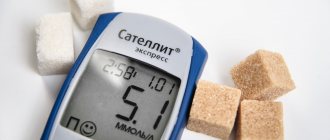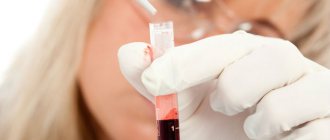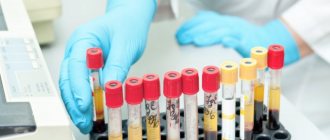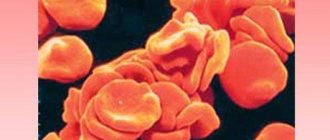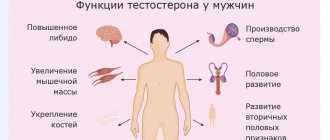Key questions: Definition and concept of diabetes. Normal blood glucose numbers. Glucose in urine. Glycated hemoglobin and fructosamines. C-peptide and other tests.
Diabetes mellitus is a group of diseases in which chronically elevated. Normally, fasting blood glucose levels are maintained between 3.3 and 5.5; after meals – up to 7.8 mmol/l.
There are other units for measuring blood glucose: mg/dL. To convert to mmol/l, the value in mg/dl must be divided by 18.
In the body, blood glucose levels are reduced by the hormone insulin , which is produced in the pancreas.
If little or no insulin is produced, or low-quality insulin is produced, or a person has had their pancreas removed, etc., the level of glucose in the blood rises and the person is diagnosed with diabetes mellitus.
Depending on the cause of the disease, the type of diabetes is determined (type 1, type 2, pancreatogenic, etc.).
In type 1 diabetes, insulin is not produced at all or very little is produced.
In type 2 diabetes mellitus, at the initial stage of the disease, insulin can be produced even in excess quantities, but its effect is weakened (due to a decrease in the body’s sensitivity to insulin or “low-quality” insulin).
In pancreatogenic diabetes, insulin is not produced after pancreatitis or removal of the pancreas.
These are the most common types of diabetes, but not all.
A separate condition is gestational diabetes mellitus, which develops in pregnant women and resolves after pregnancy.
The result is one: high blood glucose levels.
Content:
- Clinical signs of low glucose levels
- Causes of low blood sugar
- Hypoglycemia in newborns
- Hypoglycemia in a healthy person
Hypoglycemia - low blood sugar. Symptoms develop gradually, over 20-60 minutes. It occurs mainly in people suffering from type I diabetes mellitus (insulin dependent) when the rules of replacement therapy are violated. Sometimes occurs in pregnant women or newborn children. The minimum acceptable blood glucose level is 3.3 mmol/l. With decompensated diabetes, symptoms of a drop in blood sugar in a person occur already at 4.5 mmol/l. In the most severe cases, hypoglycemia can occur at 6-7 mmol/l.
Indications for use
If a patient exhibits symptoms similar to the characteristic features of diabetes mellitus, the doctor prescribes a sugar test. These symptoms include:
- decreased visual acuity;
- decreased level of performance, feeling of frequent fatigue;
- feeling of constant thirst;
- feeling of dryness in the mouth;
- rapid weight loss;
- itching and dry skin;
- frequent urination;
It is also recommended to take the test once a year for people at risk. These include:
- patients who have relatives with diabetes in their family;
- overweight women, men and children;
- women who gave birth to a child weighing more than four kilograms;
- patients taking glucocorticosteroids;
- people with tumor diseases;
- men and women who were diagnosed with heart or vascular disease in middle age.
Pregnancy is also a reason to examine the amount of monosaccharides in the body, since during this period there may be cases of hidden diabetes.
Clinical signs of low glucose levels
A drop in blood sugar, regardless of the cause, has symptoms:
- decreased intellectual abilities;
- disorientation, absent-mindedness;
- euphoria;
- drowsiness;
- lethargy;
- fog, spots before the eyes;
- a sharp, uncontrollable feeling of hunger.
When examining the patient, sweating, a jump in blood pressure, tachycardia, and pale skin are detected. If a hypoglycemic coma occurs, breathing, consciousness, and heart rhythm are impaired.
How to prepare
In order for the analysis results to be reliable, the patient needs to know that the examination requires certain preparation:
- Blood donation occurs on an empty stomach. The last meal should be 8 hours before the start of the procedure. Therefore, the most convenient time is morning.
- It is forbidden to drink anything except plain water.
- In two days you need to eliminate fatty foods and alcoholic drinks.
- On the day of delivery, you should not brush your teeth or chew gum.
- It is prohibited to take medications 3 days before the test. This is especially true for glycemic medications. If it is impossible to cancel, then you need to inform your doctor.
- Avoid smoking on the day of delivery.
- Do not subject the body to increased mental and physical stress during the day.
- The analysis does not fail after the patient has had a massage, x-ray, or ultrasound.
- You should not donate blood if there are signs of inflammation and infection.
It is important to follow all these rules, because the amount of sugar may change. Certain foods, physical activity, and possible stressful situations can increase or decrease blood sugar.
Before donating, some patients try to reduce the monosaccharide readings in the body using folk remedies. Such actions are unacceptable, since the real picture of the condition is distorted and the results will be invalid.
Causes of low blood sugar
The most common reason for low blood glucose is not eating after an insulin injection.
in patients suffering from diabetes mellitus. Such cases account for about 90% of all episodes of diagnosed hypoglycemia. The hormone, entering the bloodstream, promotes the breakdown and absorption of carbohydrates by tissues. At the same time, their plasma level decreases critically. Signs of pathology occur when there is a sharp drop in sugar levels from high numbers to low or normal levels for a healthy person (for example, from 18-19 to 5-6 mmol/l in diabetics).
Other possible causes of a sharp drop in blood sugar in patients with diabetes include:
- Administration of an excessive dose of insulin
. Occurs when the doctor selects the wrong dosage or makes mistakes when putting the drug into the syringe. It occurs mainly in people who have recently started a course of replacement therapy. The severity of the pathology directly depends on how much the required dose of the medicine was exceeded. - Increased physical activity
. During physical work, the body spends energy, which is replenished through the breakdown of carbohydrates. If a dose of insulin is administered and a person then begins to exercise or work, mild to moderate hypoglycemia may develop. - Drinking alcohol
. Regular consumption of alcoholic beverages leads to disruption of carbohydrate metabolism in the liver. The organ is unable to synthesize glucose from proteins and maintain its required level in the internal environment. This is one of the common causes of low blood sugar in men.
Hypoglycemia in newborns
Reasons for low blood sugar in children in the early stages of life:
- newborn syndrome from a mother suffering from classic or gestational diabetes;
- DM of newborns;
- iatrogenic neonatal hypoglycemia;
- other transient and unspecified disorders of carbohydrate metabolism.
Such disorders are due to the peculiarities of the production and consumption of sugars by the child’s body. Glucose consumption in the early postnatal period is about 7 g/kg body weight per day. Insufficient intake provokes activation of the processes of glycogenolysis and glucogenesis, which in the future can have unpredictable consequences.
Hypoglycemia in a healthy person
Sometimes blood sugar drops in pregnant women. This is due to hormonal changes in the body, which causes hyperproduction of insulin by the pancreas. In addition, malnutrition may be the cause of low blood sugar in a woman. The fetus consumes quite a large amount of glucose. If consumption is not compensated by food, the concentration of sugars in the internal environment decreases.
In people without diabetes, the cause of hypoglycemia is insulinoma, a hormone-producing tumor of the pancreas. At the same time, the concentration of insulin in the body increases, the content of sugars decreases. Sometimes a drop in glucose levels occurs during extreme fasting, when the body is unable to compensate for the lack of carbohydrates from internal reserves.
What may affect the results
Eating food, alcohol, certain medications, fatigue, or stress can affect your blood glucose levels.
Medicines that may cause increased blood glucose levels.
- Corticosteroid hormones (another name is glucocorticoids). They are intended to treat diseases caused by inflammation: rheumatoid arthritis, lupus, allergies. Systemic (tablet form, intravenous or intramuscular) steroids include hydrocortisone and prednisolone. However, topical steroids in creams and ointments or inhaled steroids (used to treat asthma) do not significantly affect glucose levels.
- Medications for anxiety, attention deficit disorder, depression and other mental health problems.
- Oral contraceptives (birth control pills).
- Some medications to normalize high blood pressure.
- Statins, used to lower cholesterol levels.
- Adrenaline (can be used for severe allergic reactions).
- High doses of non-inhaled asthma medications (given intravenously for severe attacks).
- Isotretinoin (used to treat acne and other dermatological conditions).
- Tacrolimus is an immunosuppressant (prescribed after organ transplantation).
- Some antiviral medications prescribed to patients with HIV and hepatitis C.
- Pseudoephedrine (a decongestant found in some cold and flu medications).
- Cough syrups (many contain sugar).
- Niacin (vitamin B3).
In addition to medications for the treatment of diabetes, the following medications and dietary supplements can reduce glucose levels:
- Aspirin.
- Aloe.
- Magnesium salicylate.
- Quinine.
To get the most reliable result, it is recommended to refrain from taking these medications until the test is taken, having agreed upon the timing of drug withdrawal with your doctor.
Female sex hormones also affect glucose levels, so a few days before your period, your glucose levels may be higher than on other days.
You can take a blood glucose test at the nearest INVITRO medical office.
A list of offices where biomaterial is accepted for laboratory research is presented in the “Addresses” section. Interpretation of study results contains information for the attending physician and is not a diagnosis. The information in this section should not be used for self-diagnosis or self-treatment. The doctor makes an accurate diagnosis using both the results of this examination and the necessary information from other sources: medical history, results of other examinations, etc.
How dangerous is this?
A long-term excess of glucose in the blood of 8 mmol/l poses a great danger to health and contributes to the development of many diseases:
- heart and blood vessels - atherosclerosis, myocardial dystrophy, myocardial infarction, gangrene of the extremities;
- nervous system - polyneuropathy, various neuralgia, encephalopathy, cerebrovascular accident (stroke)
- immune system – reduced resistance to infections and inflammatory diseases;
- musculoskeletal system - muscle wasting, osteoporosis of bones, dystrophic changes in joints (arthrosis);
- endocrine system – decreased function of the thyroid and gonads;
- metabolic disorder – deposition of fat accumulation, development of obesity;
- visual impairment – optic nerve atrophy, retinal detachment;
- development of malignant tumors.
Medical statistics show that against the background of hyperglycemia, the incidence of any pathology is much higher, and it occurs in a more severe form.
The normal blood sugar level in women, does it change with age and how can you understand that the permissible glucose level has been exceeded?
Diagnosis of diabetes mellitus
It should be noted once again that a single case of detection of sugar in the range of 70-7.9 mmol/l is not evidence of diabetes mellitus. At a minimum, the patient will be prescribed the same repeat examination. You may need to do a glucose tolerance test. If other results reveal sugar levels above 7, but up to 11 mmol/l, the doctor can diagnose diabetes with a certain degree of confidence.
There are types 1 and 2 diabetes mellitus. The first type is insulin dependent. Most often diagnosed at a young age. Occurs after a viral or autoimmune lesion of the pancreas. There is a hereditary predisposition.
Type 2 diabetes occurs when cells become resistant to insulin.
Table: “Distinctive features of diabetes mellitus types 1 and 2”
| Sign | T1DM | T2DM |
| Age | Up to 30 years old | After 40 years |
| Body mass | Pronounced thinness | In most cases, obesity |
| Nature of the onset of the disease | Spicy | Gradual |
| Course of the disease | With periods of remissions and relapses | Stable |
| Urine test result | Glucose + acetone | Glucose |
The final conclusion about the presence of the disease, as well as its type, can only be made by the attending physician. Self-medication and self-diagnosis are extremely dangerous to health.
The doctor ordered a fructosamine test. What kind of research is this?
This substance is a combination of plasma proteins with glucose; it gives the doctor information about the level of glycemia over the last 2-3 weeks.
- Blood is taken for analysis after an 8-hour fast and the normal value is 319 mmol/l.
This analysis is considered a “safety net” for glycated hemoglobin in cases where its information content is reduced, for example, in anemia. And also in cases where you need to assess the recent dynamics of blood sugar levels in recent weeks - during pregnancy in diabetic women, as well as a recent change in the diabetes treatment regimen.
Diet with sugar 7.0 – 7.9 mmol/l
Glucose levels above 7.0 mmol/L suggest a strict diet.
You will have to exclude foods such as:
- tea and coffee,
- alcohol in any form,
- sweet drinks, especially carbonated drinks,
- sugar,
- sweets,
- starchy vegetables: potatoes, corn,
- fatty meat and fish,
- honey.
When choosing food products, you must first of all pay attention to their glycemic index and the number of bread units.
Low glucose (hypoglycemia)
- Pancreatic dysfunction;
- Hypothyroidism (insufficient production of thyroid hormones);
- Insulinoma (usually a benign neoplasm that is capable of secreting insulin);
- Diseases of the liver, kidneys, adrenal glands, incl. malignant;
- adrenal insufficiency (Addison's disease);
- Hypopituitarism (impaired secretion of hormones by the pituitary gland);
- Glycogenosis (a group of hereditary diseases caused by disruption of the process of synthesis and breakdown of glycogen due to existing defects in various enzymes).
Provoking factors:
- prolonged fasting, following a strict diet or fasting;
- disruption of the gastrointestinal tract, autonomic disorders, postoperative conditions;
- overdose of insulin or other glucose-lowering drugs;
- intoxication (poisoning) with arsenic;
- alcohol abuse;
- heavy physical activity;
- feverish conditions;
- taking medications: steroids, amphetamine, etc.
Preparing for analysis
The biomaterial for research is venous or capillary blood, which is collected according to standard algorithms.
- Blood sampling is performed in the morning (8.00 – 11.00) and strictly on an empty stomach. The last meal should be at least 8-14 hours before the procedure;
- The day before, you should not overindulge in sweets, fatty and fried foods;
- Also, the day before the test, it is necessary to exclude the consumption of alcohol and energy drinks;
- It is not recommended to smoke 3-4 hours before blood sampling;
- On the day of the examination, you need to protect yourself from any physical and psycho-emotional stress.
